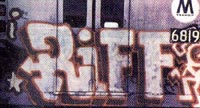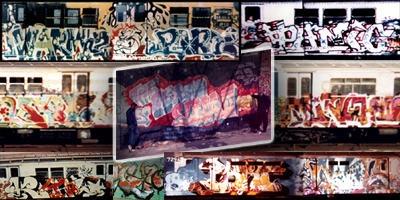|
|
By 1973 the IRT redbirds were
so covered in graffiti that fights began to break out in the
graffiti community. The city, without realizing it, gave the writers
their canvasses back by painting the fleet silver with blue stripes.
Graffiti continued at an amazing pace as more innovations developed.
The first 3-D piece was painted by the legendary Brooklyn writer
PISTOL 1, FLINT 707 followed it shortly with a 3-D top to bottom
piece. In some circles graffiti was beginning to be viewed as art.
Hugo Martinez, the founder of United Graffiti Artists - with COCO
144 as it's president, began to get media coverage for his
stable of elite writers. A list that
included: PHASE 2, STAYHIGH 149, STITCH 1, SNAKE 1, RIFF 170,
JEC STAR, BAMA, SJK 171,
C.A.T. 87 and others.

Richard Goldstein wrote a long essay
for New York magazine that featured the group
and included photo's of PHASE 2, NOVA, SNAKE 1 and all city king -
STAYHIGH 149.This article helped launch a whole new generation of
writers.1974 - More fame came to the New York City movement with the
release of "The Faith of Graffiti", a photo essay book with
arbitrary tags and pieces. At a time when most of the innovations
were coming out of the Bronx through writers like: PHASE 2, RIFF
170, PEL, TRACY 168, KING 2 and PNUT 2, "The Faith of Graffiti"
focused on Manhattan;
however, everyone agreed that STAYHIGH 149 got his
rightful props. The first "superstar crews" were gaining notoriety
in 1974. They weren't as democratic as prior crews, instead trying
to put down the best writers possible. The IND's and WANTED were
sometimes interchangeable with writers like PNUT 2, and
BILLY 167 hitting up both. THE CRAZY FIVE, led by whole car king
BLADE, developed their own unique style and dominated the 2's and
4's. By the end of the year almost every type of piece had been
painted and PHASE 2 retired as the reigning king of
style.1975- The very rare title of all city king was handed down to
three writers in 1975. If you stood on a train platform anywhere in
the city in 1975 odds were that you were going to see the names:
TRACY 168, CLIFF 159, and IN ( KILL 3 ).
The requirements needed for
this honorary title had changed since the pioneering days of JUNIOR
161 and CAY 161. Todays writer had to kill the streets and trains,
paint whole cars and window down burners, and devour whole lines
overnight with their throwups. These three met that criteria. IN had
started to popularize the throw up in late '74, by '75 it had
become huge in Brooklyn and a favorite weapon of crews like TOP, TC,
SSB and TMB. Brooklyn was also developing it's own unique piecing
style with bent hard letters made popular by UNCLE JOHN 178,
TEAR and TAIN 1. IN was also a large component of the resurgence of
the THREE YARD BOYS with CLIFF 159. 3YB and the graffiti community
were dealt a huge blow with the death of STIM 1, the first graffiti
related fatality.

1976 - Whole cars made a ressurgance with CLIFF 159, BLADE, TRACY
168, KINDU and others doing their names with cartoon characters.
CAINE 1, a prominent
writer on the 7 line with a number of whole cars to his name,
decided to paint a 10 car train for the bicentennial. ROGER, CHINO
174, DIME 139, TAGE, FLAME 1
and others painted each side of all 10 cars; the train was
immediately The city was developing a love hate relationship with
dismantled. the movement. While
it broke up CAINE's bicentennial car, it made sure to line up it's
best graffitied trains on the lay up outside Yankee stadium during
the playoffs. Graffiti began to define New York and when the TV show
"Welcome Back Kotter" aired on
ABC the opening sequence featured a shot of trains rolling by with DIABLO
and PNUT 2 pieces. LEE and the FABULOUS FIVE were gaining
favorable reviews for their whole cars, drawing comparisons to
BLADE. Between whole cars and throw ups there was a whole new
generation of writers that wanted to get back to the roots of style
and in November of 1976 THE DEATH SQUAD was formed by KOOL 131, MR.
JINX 174 and
CHAIN 3 with PART as it's first member.

"
THE DEATH SQUAD
"
In one school day they had put
together a line up of writers that would shape lettering systems for
years to come. Their influences were old school legends that
continued to write like: PEL, RIFF 170, and TRACY 168. 1977 - SOLID
1's death prompted one of the most important cars of the 1970's. As
RIFF 170 explains it: " I was playing basketball when these writers
I knew came by with bags of paint, they asked me if I wanted to
go with them to the
yards but I said no 'cause I had retired. Then they told me they
wanted to do a piece for SOLID 1 and I was down with that; it would
be my last train". RIFF improvised the outline for the entire
"SOLID, BOT, DON, RIFF" piece. It's combination of style and
wordplay inspired crews like
TDS, TMT, and CIA. 1977 also saw another landmark train with LEE's
"Doomsday" worm. While BLADE had created the conceptual piece in
1974 and had his own
unique vision, LEE's "Doomsday" piece seemed to strike a resonant chord
with writers and the public in general. LEE had just begun. By the
end of 1977, with the help of TF5 he had painted a 10 car number 5
train. Unlike CAINE's attempt the year before LEE's train actually
ran together.
The art form
hit a new plateau from Broadway writers like “PART 1”,
“CHAIN 3”, “KOOL 131”, “PADRE 2”,
“ADROCK”, “FED 2”, “TEAN”,
“KADE”. In addition, they did the best pieces in
those years as well as groups like “TDS”, “TMT”, “UA”, “CIA”,
“TSF”, “TMT”, “MAFIA”. The 6 line belonged to “SMILY
149”, “SKULL 2”, “SEEN”, “PJAY”, “DUSTER”. Whereas the
2 line and 3 line had work by “DONDI”, “NOC 167”, “COS 207”,
“ZEPHYR”, “REPEL”, and “AERON”. On the 5 line works
were done by “BLADE” & “COMET”, “BOOTS 119”, “MARK 198”,
“FRITOS”, and “KIT 17”. The 4 train one would catch
sight of a master like “MITCH 77”, and others like
“MAX 183”, “2 FAMOUS”, “BOO 2”, “DISCO 92”, “CRASH”, “KEL 1st”,
“BAN 2” , “KID 56”, as well “DUEL” who was
BAN 2's arch nemesis . There was a major
presence of several known writers on the number 7- line, such as “SON
1” & “PRO”, “CHINO 174”, “SKY 2”, “FUZZ ONE” & “FLAME PIC”,
they did the most volume of colorful works that work set the trend
many newer writers to that line to follow .
FBA”
took over where “TDS” left off on the 1 line and took style into a
new direction. “AIRBORN”, “SPADE 127”,
“TACK”, “KAZE”, and “RASK “left an
impression on writers in the mid to late 80’s. However, “SKEME”
& “DEZ” had the most cars running during those years.
“CAP” & “PJAY” took on a war that lasted for years,
which was depicted in the film
“Style Wars” which was released in 1982. Inside
artists, who were very overlooked in the history of writing,
displayed a very artistic calligraphy hand writing style that many
reveled over. Writers like “ZEPHYR”, “BT/BADTAXI”, “FLIN
TOP”, “G-WIZ”, “OE3”, “P13”, “SOE”, “PEO”, “CRIME 79” “BABY 168”, “BADBID”,
took over the BMT’S. However, on the 2’s and 5’s there was a
consistent presence by “BOMOO5”, “SEEN TC5”, “DOZE”, “TC5”, “SKEME”,
“AGENT”, “RUSH & “REST” MPC” , “DURO”, “KIST”, “ BT ” “ JOE
NUTs” “SES”. On the 4 line the biggest inside king was
“BAN 2” (a.k.a.
“DELI 167”), but others like “DUEL”, “MAURICE
167”, “PEPSI”, “ARAB”, “DIL”, “SED 2”, “RUB 5”, and
“REC 2”, also held a consistent presence.
Graffiti was coming to an end on most
of the subway lines. The 7 line was painted
all white and
shortly after painted red, which became untouchable to the artists
that sought them. But there where some hard core writing groups,
that continued on many other lines, such as “RTW”, and “TNB-TAT”. “T-KID
170”, “CEM 2”, “KENN”, “MACK”, “BIO”,
“SHAME 125” were the main members of the groups “TNB-TAT”.
They kept away un-welcomed visitors to train yards, such as the
“Ghost Yard” as well as a few other IRT locations. Other writers
like “DELTA 2”, “SHARP”, “SERVE”, “RIZE”, “SADE” & “DUNE”,
“SASH”, SAK was the known king of Broadway from 1984 to
1986. “FLITE”, “POEM”, “POKE”, “WEST”, “JON 1”,
“CAP” POVE , , “COPE 2”, and “CONE”
were names also consistently seen on IRT’s. “RTW” ( Rolling
Thunder Writers) was one
of the most dominant writing groups of their time originally put together by
Broadway writer “BIL ROCK 161” in 1976. BIL ROCK
and his original Squad, REVOLT, HUGHIE, VANDAL,
ZEPHYR, MACKIE, SAURON, MIN and RASTA owned the Broadway
number one line inside and out.
It was BILROCK and
REVOLT who started the city-wide RTW onslaught in
late 1978, painting the A's, AA's, CC's, E's, F's, B's, RR's,
N's, M's, QB's, D's, 3's and 7 train. BILROCK was the
Graff world's contact for Jean-Michel Basquiat, it was him whom he
asked to get down with the C.Ahearn Times Square show in 1980
(before LEE and FAB -FIVE- FREDDY). BILROCK was also
responable for bringing all of the writers to the Esses studio in
1980.
BILROCK
would later hand the
group over to NE (a.k.a. “MIN ONE”).
“NE” then helped them became one of the all-time bombing groups.
“RTW” or sometimes referred as “RTW WOW” held a very strong presence
on the BMT’s, as well as, a very intimidating presence among other
competitors looking for recognition. The most notable members
of the groups were “PADE” (a.k.a. “PD”),
“TRIKE GND” (a.k.a. “TO”), “MIN”
(a.k.a. “NE”), “RICH 2” (a.k.a.”
RH”), “BOE”, “SAGO”, “QUIK”,
“SACH”, “HAZE” (a.k.a. “SE 3”)
kept other writers out of the Coney Island Yard and the City Hall lay
ups. However, there were other writers who were also seen
consistently during this period; “MAGOO 2”, “DEMO”, “WEBONE”,
“TRACK 2” (a.k.a. – “TEKAY”,
“GHOST”, “STRIDER”, “ICEMAN LSD”,
“SASH”, “REC 127”, “NEO”,
KP, AT, “JOZ”, “JON ONE”.
New York City transit
was basically clean except for the 5 line in the Bronx and the J &
LL lines in Brooklyn. Many writers had quit and very few kept up
the movement going. During these years, groups like the “RIS” crew,
“COD”, “TC5”, “AOK”, produced some of the nicest whole cars of the
time. By September 1989, the last train was cleaned which lead many
writers to quit due to the severity of the laws and jail time that
was given. Regardless of the new strict laws, very few of the
painters continued the Graffiti movement like “KET”, “GHOST”,
“VEN”, “SAR”, “VEEFER”, “CAV”,
“MIN 1”, “IZ THE WIZ” & “FUZZ ONE”.
They called this movement the “Clean Train Movement”.
|



